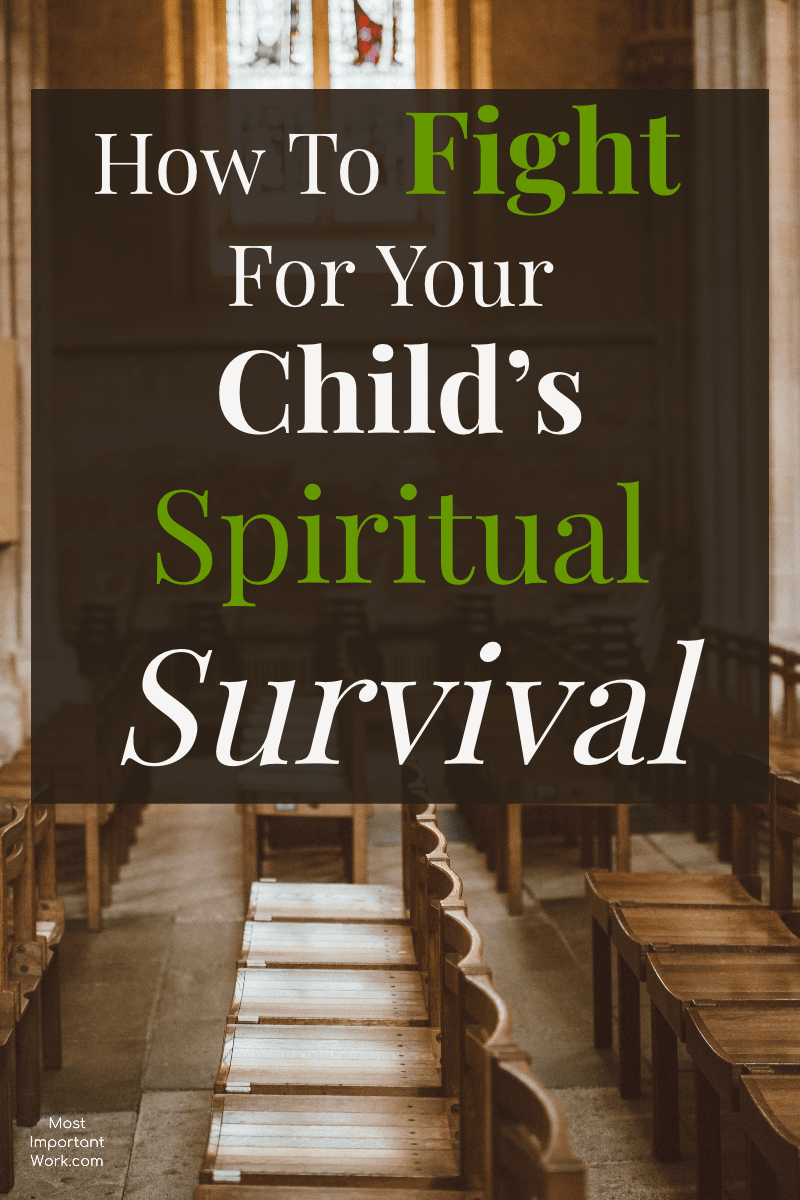
Reading Time: 3 min 14 sec
Have you ever searched for Christian children’s books only to shake your head in dismay? I have only just realized that for most of my life, I have had this thought that Children’s Christian literature is subpar, a chotskies, something you stick in an Easter basket or as an “extra” gift on Christmas morning because you feel like you should.
Even as a child, it seemed like most Christian picture books were trying to portray this cotton candy outlook on life, light but rarely formative. They were what you read at Grandma’s when you were bored with literally nothing else to do.
It is not until now, as a mother, that I realize that alongside the cotton candy are books dripping with gold. These books rarely make it to the bestseller list and are hidden in out-of-the-way nooks, but they are formative to our child’s walk with Jesus. We are going to be talking about 14 Powerful Books that will ignite your children’s faith.
1. Children Learn Through Experience
2. The Power of a Truly Great Book
3. How to Read Christian Picture Books
4. 14 Powerful Picture Books
1. Children Learn Through Experience
I discovered that reading stories is not just a way to pass the time or to make sure our child is receiving a solid foundation in Christianity, but as a powerful tool in their walk with Jesus.
Children learn through experience and even though as parents we would like to open their heads and stick in all the right answers to life’s greatest questions, we can’t. While we have good intentions, the fact is that all of the knowledge in the world cannot trump experience.
My mother loves recounting the story (okay hundreds of them) of myself as a toddler, and my fascination with the stove. She would constantly tell me, “Alexis, don’t touch that, you will get burned.” But no matter how many times she said it, I didn’t believe her. I reached out touched that stove, and truly experienced the meaning of the word “hot”.
Fortunately, through the power of stories (and the graciousness of the Holy Spirit) our children can experience many different situations and see the consequences without ever leaving the comfort of the couch. Books allow us to experience truth without having to walk through the pain.
2. The Power of a Truly Great Book
Did you ever read a book as a child that’s truths stick with you to this day? The book that shaped me, was Anne of Green Gables. This book which has so captured the hearts of millions of people depicts the beauty of ordinary life. It showed us how to observe the world around us, how to bask in the beauty of today, how to invest in relationships even when they are messy, how to love well, and how to persevere.
Great books invite you to reflect, allow you to discover, spark your imagination, call out the beauty in the world, and inspire you to new heights. Great books read in community, as a family curled up on a couch, give you a shared vocabulary, a way of relating to each other and the world around you. They not only build life-long memories, as you wrestle together, with ideas and concepts, but they allow your child to form their outlook on life.
Reading great Christian books together as a family isn’t just a good idea, or something to check off the to-do list, but a simple, yet powerful tool in the investment of your child’s walk with God.
We all learn best in the context of a story.
3. How To Read Christian Picture Books
I adore books. I love surrounding my children with life-changing literature. However, if I bought every book I read I would need another house. 🙂
The more I read about the spiritual development of children the more I realize the importance of providing select tools for their spiritual development. I look at these picture books as something comparable to what a journal or podcast would be for adults. I would plan to add these titles to your collection over time. 🙂
Unlike books for educational purposes, the goal is not to finish. I know shocker, right! The goal is to allow space to be present to each other, to listen to the still, soft voice of the Holy Spirit, to wonder, and ask questions.
As YOU read, don’t hurry to turn the page, but take the time to take in the illustrations. At the end, do not rush to teach or share the moral of the story. Trust that the Holy Spirit is touching your childs heart.
Instead, invite discussion. Ask your child what they thought and felt as they experienced this book. This doesn’t have to be a long-drawn-out affair. Yes, this can be done with active children. 🙂 Remember that whether you can see it or not the Holy Spirit is at work in the heart of your child. Enjoy!
4. 14 Powerful Picture Books
Grab your FREE Beginner Guide to The Deeper Life and join our community of moms who are hungry for more of Jesus in their lives and in the lives of their children.
What about you? What is your favorite Christian children’s picture book? Leave a comment, and don’t forget to follow Most Important Work on Pinterest!
[/et_pb_text][/et_pb_column][/et_pb_row][/et_pb_section]

Reading Time: 4 min 46 sec
Developing our faith can feel so elusive. We all have these great intentions of starting a new devotional, studying our Bible, praying for our loved ones, or even journaling; only to get sidetracked, when life gets in the way.
We struggle with feelings of discouragement, embarrassment, and even feel a little ashamed. Why is investing in our faith so hard? Doesn’t God want us to have a deep relationship with him? Surely, at this stage in our lives, we should already know how to develop our faith. We lay awake at night and wonder, is my current experience of God all I can expect on earth?
We secretly hope our friends never find out the real state of our spiritual lives. We feel like an imposter, as we say all the right things while trying to stuff our discouragement deep inside. We paste on a smile, throw ourselves into more church activities, hoping against hope that God will transform our lackluster relationship into a vibrant friendship with him.
So how do we find our faith when we get sidetracked? How do we experience a thriving relationship with God? How do we throw off our feeling of imposter syndrome and embrace everything God has for us today?
Here are three practical ways to move towards Jesus without having to become a nun. 🙂
Finding Faith: The Goal
Finding Faith: Journey Together
Finding Faith: All About Community
1. Finding Faith: The Goal
We can sometimes get so distracted with the beautiful new cover of the latest devotional that we forget its purpose. We need to ask ourselves, why are we using this resource? Is it because all our friends are using this devotional and we don’t want to be left out?
The completion of spiritual resources does not equate with a deep relationship with God. Let me say this again, God desires a relationship with us, not the completion of a spiritual tool. “Spiritual people are not those who engage in certain spiritual practices; they are those who draw their life from a conversational relationship with God.” -Dallas Willard
Our focus as followers of Jesus should be an authentic relationship with God. We can’t lose sight of the goal. So, what does this practically look like?
First, we spend time in prayer, talking, and listening to God. This is key because we could go for days on a nonstop monologue of our thoughts and feelings. It can be easy to forget that just because we can’t see God doesn’t mean he isn’t talking to us. We need to practice listening for God’s voice.
Second, don’t feel the need to complete a book, resource, or practice because you need to get all the information to grow. Transformation is not the result of a firehose of information. It is about thoughtful interaction with the current work of the Holy Spirit in your life.
Third, we need to ask the Holy Spirit for direction. He is always faithful to lead us to the next step (or resource) in our spiritual journeys.
2. Finding Faith: Journey Together
In the United States, we have several unspoken values as a country. One of those values goes by several names: autonomy, self-sufficiency, independence, etc. Our culture will tell us that we are so evolved that we can develop our faith in isolation. As long as we have access to the trendiest tv preacher and the latest women’s devotional, that we can grow all by ourselves.
And we can…until we can’t. You see, we forget that Christianity is a counter-cultural way of life. We were not designed to live a life with God in isolation. We were created to live life together in community.
Hebrews 10:24-25, “And let us consider how we may spur one another on toward love and good deeds, not giving up meeting together, as some are in the habit of doing, but encouraging one another—and all the more as you see the Day approaching.”
We wonder why our relationship with God consists of good intentions and half-finished conversations. We need each other to offer support, encouragement, and accountability. We need to surround ourselves with like-minded people to grow in our faith.
Ruth Haley Barton says it this way, “The purpose of journeying together in spiritual friendship and spiritual community (whether there are just two of you or whether you are in a small group) is to listen to one another’s desire for God, to nurture that desire in each other and to support one another in seeking a way of life that is consistent with that desire. ”
She says community is all about listening to each other, nurturing the desire for God in each other, and supporting each other in pursuing him. Life will happen. Spiritual community offers you encouragement and accountability to pursue Jesus even when your schedule is busy.
When we are tempted to push God to the back burner, our community reminds us of who we are and where we are going. We need each other.
3. Finding Faith-All About Community
So, what are we looking for in a community? We need to understand that there is no perfect group. As followers of Jesus, we are all broken people at various stages in our spiritual development. We all desperately need God’s grace (and each other’s) as we pursue Jesus together.
Dallas Willard says like this, “Spiritual formation cannot, in the nature of the case, be a ‘private‘ thing, because it is a matter of whole-life transformation. You need to seek out others in your community who are pursuing the renovation of the heart.”
There is no perfect community. Life together will be messy. We are all in the process of transformation. However, here are some of the key values to look for when you are joining a group. One of the ways you can find community is by participating in a small group at your local church.
- Authenticity- The value of saying the real thing not the right thing.
- Encouragement– The value of an encouraging and supportive environment.
- Accountability– The value of accountability spoken with grace, wisdom, and love.
- Like-Minded– The value of intentionally pursuing Jesus together
- Prayer Support– The value of intentionally praying over each other.
- Relationships– The value of intentionally forming relationships with each other.
Are you hungry to know and experience a deeper relationship with God? Do you dream of participating in an authentic community, where together you encourage one another, in your relationship with Jesus? If so, join our waitlist for the Deeper Life Community. While you wait, you will receive for FREE our Deeper Life Beginners Guide and will be the first to know when registration opens. Grab your guide today!
Remember these three steps to finding your faith when you get sidetracked. Our focus as followers of Jesus should be an authentic relationship with God. Second, we are on a spiritual journey together. Third, we find support and accountability by participating in community together.
What about you? What is your #1 issue when it comes to pursuing a relationship with Jesus when you get sidetracked? Leave a comment, and don’t forget to follow Most Important Work on Pinterest!
[/et_pb_text][/et_pb_column][/et_pb_row][/et_pb_section]

Reading Time: 6 min 19 sec
“Mommy!” a yell ripped through a fog of sleep, sending me bolt right up in bed. I scrambled to my feet and raced toward the sound. Throwing open the door, I fell to my knees beside her bed and gathered her up in my arms.
Between gasping sobs, the story of the terrifying nightmare unfolded. She clung to me, refusing to let go.
Fear can be a paralyzing enemy.
We are all in a spiritual battle. Our children are not exempt from the lies, fear, and twisted plans of Satan. All throughout the Bible, there are examples of Satan’s single-minded purpose for our destruction. It began with the lie in the Garden of Eden, and then he wove his way through the lives of men and women throughout history.
We are going to talk about how to use prayer to fight for your child’s spiritual survival.
1. Pray For Your Child: Protection
2. Pray For Your Child: Our Role
3. Pray For Your Child: Warfare Prayers
1. Pray For Your Child: Protection
In our enlightened culture, the concept of demons and angels can feel like something out of a Hollywood movie, right up there with zombies. The whole idea just doesn’t seem real. With our obsession with control, we don’t like to spend much time contemplating that there are forces we can’t see that are fighting for our destruction. It can feel so juvenile.
But Peter the apostle has a different message for us, “Be alert and of sober mind. Your enemy, the devil prowls around like a roaring lion, looking for someone to devour. Resist him, standing firm in the faith, because you know that the family of believers throughout the world is undergoing the same kind of sufferings.” 1 Peter 5:8
He says be alert, resist Satan by standing firm in the faith. And know that you are not alone in your sufferings. We need to remember that as we face challenging situations or experiences, they are not always a direct result of a demonic attack, but could also be the result of living in a sinful world where there is pain and suffering.
Jesus himself underwent a severe (and blatant) testing by Satan in Matthew 4:1-11. It says this, “Then Jesus was led by the Spirit into the wilderness to be tempted by the devil. After fasting forty days and forty nights, he was hungry. The tempter came to him and said, “If you are the Son of God, tell these stones to become bread.”
–Satan strategically attacks us most often when we are weak. He waited until Jesus was physically and mentally depleted from fasting before he struck. It says, “Jesus was hungry”.
“Jesus answered, “It is written: ‘Man shall not live on bread alone, but on every word that comes from the mouth of God.” Then the devil took him to the holy city and had him stand on the highest point of the temple. “If you are the Son of God,” he said, “throw yourself down. For it is written: “‘He will command his angels concerning you, and they will lift you up in their hands so that you will not strike your foot against a stone.’”
–Satan strategically attacks our identity. Multiple times he challenges Jesus with these words, “If you are the Son of God”.
“Jesus answered him, “It is also written: ‘Do not put the Lord your God to the test.’” Again, the devil took him to a very high mountain and showed him all the kingdoms of the world and their splendor. “All this I will give you,” he said, “if you will bow down and worship me.”
-Satan is a liar. He loves to weave webs of illusion. It says, “He showed Jesus the kingdoms of the world” and then had the gall to tell Jesus that he ruled the world.
“Jesus said to him, “Away from me, Satan! For it is written: ‘Worship the Lord your God, and serve him only.’ Then the devil left him, and angels came and attended him.”
-Satan is also persistent. He attacked Jesus three times before he finally left.
We live between the first and second coming. And until Jesus returns, Satan is determined to prevent our children from having a deep relationship with Jesus. Satan doesn’t fight fair. He doesn’t wait until our children are grown up: to start attacking them with fear, lies about their identity, and anything else that would drive a wedge between your child and God.
2. Pray For Your Child: Our Role
Our role as parents is to protect and equip our children from Satan’s webs of deceit. In 1 Peter 5:2-3 it says, “Be shepherds of God’s flock that is under your care, watching over them—not because you must, but because you are willing, as God wants you to be; not pursuing dishonest gain, but eager to serve; not lording it over those entrusted to you, but being examples to the flock.”
We are called to be shepherds for our children. Serving them by guarding and protecting their hearts against the schemes of the enemy.
Here are a couple of ways we can shepherd our children.
a. Serve as Prayer Warrior
We are called to protect our children by covering them in prayer. We pray protection over their hearts, their minds, their souls, and their bodies. We pray that guardian angels would surround them through the day and night. We pray against the lies of the enemy and that God would replace those lies with his truth. We pray a blessing over them, and that their hearts would always be soft to the things of God.
b. Equip Your Child
We are called to equip our children with tools needed to resist Satan. God, in his infinite mercy, and love gave us several tools at our disposal to stand firm against Satan’s plans. The first of which is the Holy Spirit, who serves as a guide helping us discern between spirits. (1 Cor. 12:10) We can teach our children to invite the Holy Spirit daily into their lives. Asking him to give them ears to hear his voice.
Ephesians chapter six is another tool that serves as a model for teaching our children to daily put on the armor of God. It says, “Finally, be strong in the Lord and in his mighty power. Put on the full armor of God, so that you can take your stand against the devil’s schemes. For our struggle is not against flesh and blood, but against the rulers, against the authorities, against the powers of this dark world and against the spiritual forces of evil in the heavenly realms.
Therefore, put on the full armor of God, so that when the day of evil comes, you may be able to stand your ground, and after you have done everything, to stand. Stand firm then, with the belt of truth buckled around your waist, with the breastplate of righteousness in place, and with your feet fitted with the readiness that comes from the gospel of peace.
In addition to all this, take up the shield of faith, with which you can extinguish all the flaming arrows of the evil one. Take the helmet of salvation and the sword of the Spirit, which is the word of God.” Ephesians 6:10-17
Prayer is crucial to your child’s ability to resist Satan.
c. As An Example
Children learn best through experience, and your daily relationship with God is a living model for your children. As you experience new depths to your relationship with God that hunger and love for God spills out into all of your relationships. You can teach your children how to stand firm against the lies of Satan all day long but what sticks with them is your own relationship with God. More is caught than taught.
3. Praying For Your Child: Warfare Prayers
Preparing and interceding for your child doesn’t have to be overwhelming. Here are a couple of ideas of warfare prayers that are very effective and only take a couple of minutes.
- Armor of God Prayer
“Therefore, put on the full armor of God, so that when the day of evil comes, you may be able to stand your ground, and after you have done everything, to stand. Stand firm then, with the belt of truth buckled around your waist, with the breastplate of righteousness in place, and with your feet fitted with the readiness that comes from the gospel of peace. In addition to all this, take up the shield of faith, with which you can extinguish all the flaming arrows of the evil one. Take the helmet of salvation and the sword of the Spirit, which is the word of God.” Ephesians 6:13-17,
- Protection over Hearts and Minds
“Father, We ask that you would guard _____(child’s name) and keep ___ (him/her) safe. We ask that you would put a hedge of protection around_____ (his/her) heart, mind, body, and soul. Surround ______(him/her) with your guardian angels and uproot any lies from Satan and replace them with your truth. Remind____ (him/her) of who _____(he/she) is, your beloved child. Let ____(him/her) experience the depth of your lavish love today. We love you and praise you. In Jesus’ name, Amen.”
- Protection over Your Child As They Sleep
- Pray Protection for Travel
- Pray Your Own Prayer Based on Childs Circumstances
If you want to know how to get started in living a deep life with God; grab our Deeper Life Beginners Guide (below). And join our community of moms who are hungry for more Jesus in their lives and in the lives of their families.
What about you? What is your #1 issue when it comes to praying for your kids? Leave a comment, and don’t forget to follow Most Important Work on Pinterest!
[/et_pb_text][/et_pb_column][/et_pb_row][/et_pb_section]














